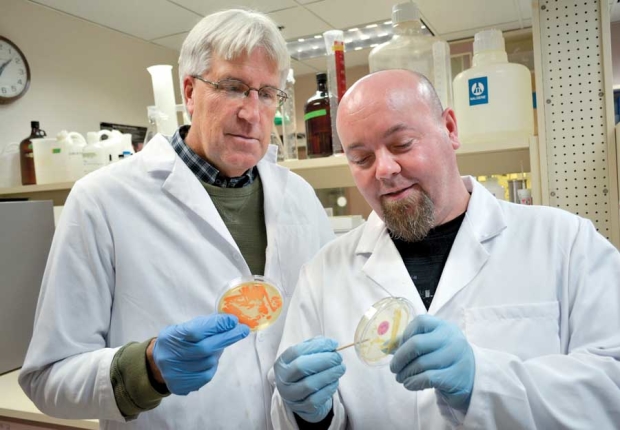
Entomologist Alan Knight (left), and technician Ben Zeigler, is doing research using baker’s yeast and sugar to make codling moth controls more effective. (Courtesy USDA-ARS)
A U.S. Department of Agriculture entomologist is exploring low-cost adjuvants, such as yeasts, that could increase the efficacy of codling moth controls.
Dr. Alan Knight, at the Yakima Agricultural Research Laboratory in Washington, and colleague Dr. Peter Witzgall, chemical ecologist at the Swedish University of Agricultural Sciences in Alnarp, found that the codling moth granulosis virus was more effective when combined with yeast and sugar.
The virus is applied to orchards as a biological control for codling moth, a serious pest of apple and pear. When ingested, the virus infects the gut of the larva.
As the infection advances over the course of about a week to ten days, the larva stops feeding, turns black, and dies. The virus is specific to codling moth and harmless to beneficial insects and humans.
Most commercial formulations of the virus have not provided consistent control, scientists report. It degrades rapidly in ultraviolet light and high temperatures and usually does not kill codling moth larvae fast enough to stop them burrowing into the fruit.
Knight and Witzgall came up with the idea of applying yeast and sugar with the virus to increase the likelihood of the larva ingesting it. This followed earlier findings that wild yeasts are important for larval health and survival and could serve as feeding stimulants.
In two years of field trials, virus sprays with sugar and the wild yeast Metschnikowia pulcherrima as an adjuvant killed 83 percent of the larvae, whereas the virus alone killed only 55 percent.
In one of the two years, the virus with adjuvant resulted in less feeding injury than the virus alone.
The scientists then tried adding either sugar or yeast to the virus but found them less effective alone than in combination.
“We believe the sugar helps the yeast to grow, creating attractive volatiles that stimulate feeding, and that increases larval death through greater contact with the virus,” Knight reported.
While it definitely was an improvement over the virus alone, the adjuvant didn’t make the virus last longer, Knight stressed. It just increased the chances that larvae would be enticed to ingest it.
Pear ester
Knight then explored the idea of adding a pear ester (ethyl decadienoate), which he and Dr. Doug Light, entomologist with the USDA in Albany, California, developed some years ago as a lure for codling moth traps. It is known as the DA (Doug and Alan) lure.
The pear ester is not a feeding stimulant, but more of a disruptant. For example, it typically makes codling moth females lay eggs further away from the fruit, and it prevents many larvae from finding the fruit, which they need to continue their development.
Instead of adding the pear ester to the virus, Knight felt a more successful strategy would be to add it to a product that didn’t have to be completely ingested in order to kill the pest, such as topical insecticides. He found the pear ester worked well in combination with the conventional pesticide Altacor (rynaxypyr) and the organic pesticide Entrust (spinosad), even in pear orchards.
Results were particularly promising with Entrust. The pear ester does not yet have organic certification, but Knight said it appears likely to qualify.
He also tested the feeding stimulant Monterey Insect Bait, which is made of unpasteurized corn steep liquor, but with less success.
He’s now testing bread yeast, Saccharomyces cerevisiae, with pear ester as an adjuvant with Altacor and Delegate (spinetoram).
Bread yeast is more widely available and cheaper than other species of wild yeasts. Although his research hasn’t focused on optimum rates, Knight has been applying one to three pounds of yeast per acre in standard air-blast applications.
He believes this has the potential to be a useful tool for growers.
“Bread yeast is pretty cheap,” he said, “And the one-pound rate plus one pound of sugar would be a minimal additional cost for the spray.”
The research has been funded by the California Pear Advisory Board and the Washington Tree Fruit Research Commission. •






Leave A Comment